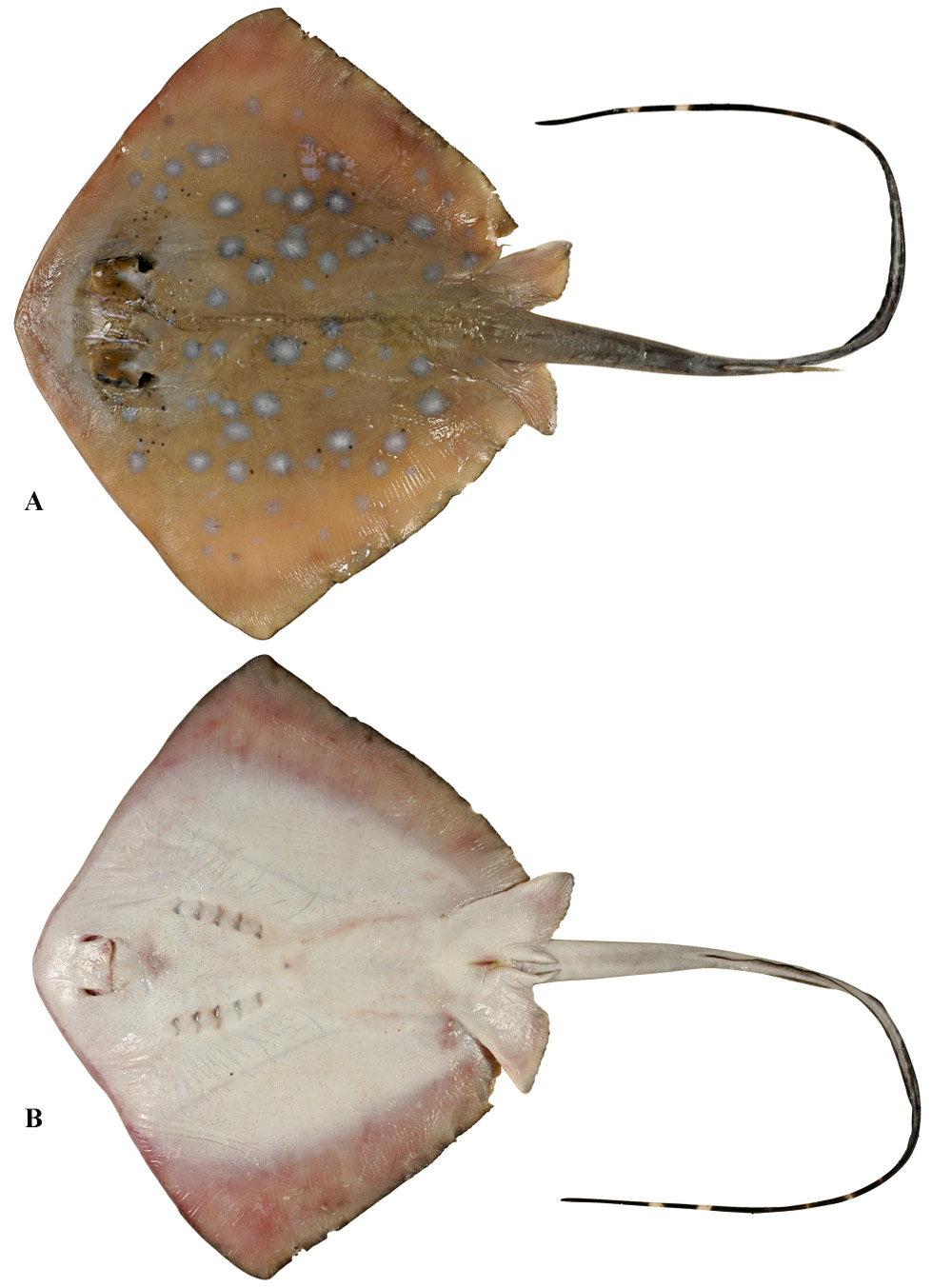Neotrygon australiae
Last, White & Séret, 2016
Classification: Elasmobranchii Myliobatiformes Dasyatidae
Reference of the original description
Taxonomic status of maskrays of the Neotrygon kuhlii species complex (Myliobatoidei: Dasyatidae) with the description of three new species from the Indo-West Pacific. Zootaxa, 4083(4), 533–561
Taxonomic status of maskrays of the Neotrygon kuhlii species complex (Myliobatoidei: Dasyatidae) with the description of three new species from the Indo-West Pacific. Zootaxa, 4083(4), 533–561
Types
Neotrygon australiae
Holotype: CSIRO: H 7016-01; Paratype: CSIRO: CA 3236; CSIRO: CA 3247; CSIRO: CA 4307; CSIRO: H 3914-01; CSIRO: H 6144-19; CSIRO: H 7017-01; CSIRO: H 7018-01; CSIRO: T 693;
Neotrygon australiae
Holotype: CSIRO: H 7016-01; Paratype: CSIRO: CA 3236; CSIRO: CA 3247; CSIRO: CA 4307; CSIRO: H 3914-01; CSIRO: H 6144-19; CSIRO: H 7017-01; CSIRO: H 7018-01; CSIRO: T 693;
Description :
Citation: Neotrygon australiae Last, White & Séret, 2016: In: Database of modern sharks, rays and chimaeras, www.shark-references.com, World Wide Web electronic publication, Version 01/2026
Please send your images of "Neotrygon australiae" to info@shark-references.com

Holotype of Neotrygon australiae sp. nov. (CSIRO 7016-01, juvenile male 235 mm DW) from Queensland, Australia (fresh): (A) dorsal view; (B) ventral view

Holotype of Neotrygon australiae sp. nov. (CSIRO 7016-01, juvenile male 235 mm DW) from Queensland, Australia (fresh): (A) dorsal view; (B) ventral view
Common names
Australian Bluespotted Maskray
Australian Bluespotted Maskray
Short Description
Original Diagnosis after LAST, WHITE & SÉRET, 2016 [23790]: A large Neotrygon of the kuhlii-complex (reaching at least 45 cm DW; males maturing at ~28 cm DW) with the following combination of characters: disc much broader than long, width 1.2–1.3 times length; pectoral apices narrowly angular; snout fleshy, broadly rounded to weakly angular, angle 101–103°, length 1.6–2.1 times interorbital width; maximum width relatively well back on disc, length from snout tip to pectoral-fin insertion 1.7–1.8 times and disc width 2.3–2.5 times horizontal distance from snout tip to maximum disc width; preoral length 1.8–2.3 times mouth width; internasal distance 1.3–1.6 in prenasal length; interspiracular distance 14–16% DW; nostril length 3.4–4% DW; nasal curtain width 8.4–9.1% DW; small mouth, width 6.5–7.3% DW; horizontal distance from cloaca to caudal sting base 42–52% of disc length; thornlets present in nuchal and lumbar regions in large individuals, absent from tail in all sizes; dermal denticles entirely absent from body; pectoral-fin radials 105–113; total vertebral centra (including synarcual) 129–134, trunk centra (including synarcual) 37–41; blue spots large, largest spot on disc 0.7–1.2 times eye width; 2–17 (mean 9.4) blue spots on medial belt, largest 3.3–5.6% DW; mask-like marking subtle, usually lightly covered with dark peppery spots (dark spots not widespread over central disc); ventral surface of disc with distinct dark greyish brown submarginal bands; ventral tail fold almost entirely dark.
Original Diagnosis after LAST, WHITE & SÉRET, 2016 [23790]: A large Neotrygon of the kuhlii-complex (reaching at least 45 cm DW; males maturing at ~28 cm DW) with the following combination of characters: disc much broader than long, width 1.2–1.3 times length; pectoral apices narrowly angular; snout fleshy, broadly rounded to weakly angular, angle 101–103°, length 1.6–2.1 times interorbital width; maximum width relatively well back on disc, length from snout tip to pectoral-fin insertion 1.7–1.8 times and disc width 2.3–2.5 times horizontal distance from snout tip to maximum disc width; preoral length 1.8–2.3 times mouth width; internasal distance 1.3–1.6 in prenasal length; interspiracular distance 14–16% DW; nostril length 3.4–4% DW; nasal curtain width 8.4–9.1% DW; small mouth, width 6.5–7.3% DW; horizontal distance from cloaca to caudal sting base 42–52% of disc length; thornlets present in nuchal and lumbar regions in large individuals, absent from tail in all sizes; dermal denticles entirely absent from body; pectoral-fin radials 105–113; total vertebral centra (including synarcual) 129–134, trunk centra (including synarcual) 37–41; blue spots large, largest spot on disc 0.7–1.2 times eye width; 2–17 (mean 9.4) blue spots on medial belt, largest 3.3–5.6% DW; mask-like marking subtle, usually lightly covered with dark peppery spots (dark spots not widespread over central disc); ventral surface of disc with distinct dark greyish brown submarginal bands; ventral tail fold almost entirely dark.
Distribution
northern Australia, off Daru (northern Torres Strait Islands) in Papua New Guinea and Lombok in Indonesia [23790] Source: www.gbif.org
northern Australia, off Daru (northern Torres Strait Islands) in Papua New Guinea and Lombok in Indonesia [23790] Source: www.gbif.org
Remarks
shark-references Species-ID=14547;
shark-references Species-ID=14547;
Parasites (arranged by Jürgen Pollerspöck)
Cestoda
Cestoda
- Echinobothrium tyleri Dallarés & Kuchta, 2024 [32915]
















